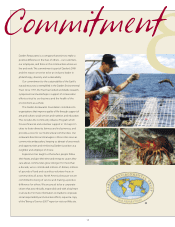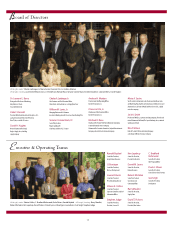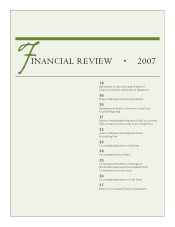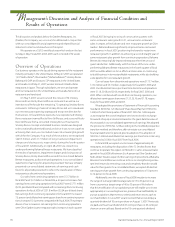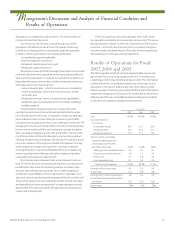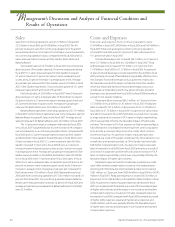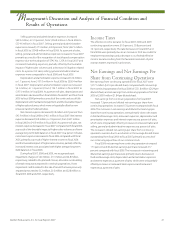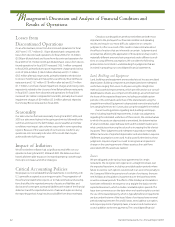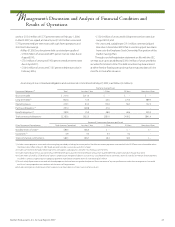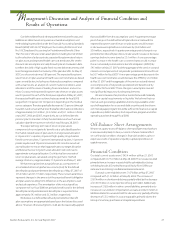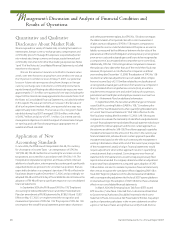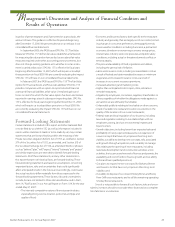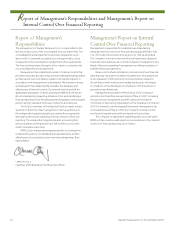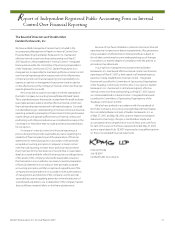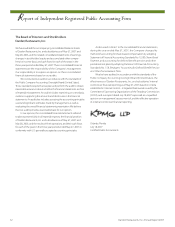Red Lobster 2007 Annual Report Download - page 24
Download and view the complete annual report
Please find page 24 of the 2007 Red Lobster annual report below. You can navigate through the pages in the report by either clicking on the pages listed below, or by using the keyword search tool below to find specific information within the annual report.
22 Darden Restaurants, Inc. Annual Report 2007
Management’s Discussion and Analysis of Financial Condition and
Results of Operations
M
Losses from
Discontinued Operations
On an after-tax basis, losses from discontinued operations for fiscal
2007 were $175.7 million ($1.18 per diluted share) compared with
losses from discontinued operations for fiscal 2006 of $13.6 million
($0.08 per diluted share) and losses from discontinued operations for
fiscal 2005 of $9.3 million ($0.06 per diluted share). Losses from discon-
tinued operations for fiscal 2007 increased $162.1 million compared
to fiscal 2006, primarily due to asset impairment charges and closing
costs of $236.4 million ($146.0 million after tax) and $13.7 million
($8.5 million after tax), respectively, primarily related to the decision
to close or hold for sale all Smokey Bones and Rocky River Grillhouse
restaurants and $12.7 million ($7.8 million after tax) and $2.7 million
($1.7 million, net of tax) of asset impairment charges and closing costs,
respectively, related to the closure of nine Bahama Breeze restaurants
in fiscal 2007. Losses from discontinued operations for fiscal 2006
increased $4.3 million compared to fiscal 2005, primarily due to asset
impairment charges of $8.4 million ($5.2 million after tax) related to
five Smokey Bones restaurants in fiscal 2006.
Seasonality
Our sales volumes fluctuate seasonally. During fiscal 2007, 2006, and
2005 our sales were highest in the spring and winter, followed by the
summer, and lowest in the fall. Holidays, severe weather and similar
conditions may impact sales volumes seasonally in some operating
regions. Because of the seasonality of our business, results for any
quarter are not necessarily indicative of the results that may be
achieved for the full fiscal year.
Impact of Inflation
We do not believe inflation had a significant overall effect on our
operations during fiscal 2007, 2006 and 2005. We believe we have
historically been able to pass on increased operating costs through
menu price increases and other strategies.
Critical Accounting Policies
We prepare our consolidated financial statements in conformity with
U.S. generally accepted accounting principles. The preparation of
these financial statements requires us to make estimates and assump-
tions that affect the reported amounts of assets and liabilities and
disclosure of contingent assets and liabilities at the date of the financial
statements and the reported amounts of sales and expenses during
the reporting period. Actual results could differ from those estimates.
Critical accounting policies are those we believe are both most
important to the portrayal of our financial condition and operating
results and require our most difficult, subjective or complex
judgments, often as a result of the need to make estimates about
the effect of matters that are inherently uncertain. Judgments and
uncertainties affecting the application of those policies may result in
materially different amounts being reported under different condi-
tions or using different assumptions. We consider the following
policies to be most critical in understanding the judgments that are
involved in preparing our consolidated financial statements.
Land, Buildings and Equipment
Land, buildings and equipment are recorded at cost less accumulated
depreciation. Building components are depreciated over estimated
useful lives ranging from seven to 40 years using the straight-line
method. Leasehold improvements, which are reflected on our consoli-
dated balance sheets as a component of buildings, are amortized over
the lesser of the expected lease term, including cancelable option
periods, or the estimated useful lives of the related assets using the
straight-line method. Equipment is depreciated over estimated useful
lives ranging from two to 10 years, also using the straight-line method.
Our accounting policies regarding land, buildings and equip-
ment, including leasehold improvements, include our judgments
regarding the estimated useful lives of these assets, the residual values
to which the assets are depreciated or amortized, the determination
of what constitutes expected lease term and the determination as to
what constitutes enhancing the value of or increasing the life of exist-
ing assets. These judgments and estimates may produce materially
different amounts of reported depreciation and amortization expense
if different assumptions were used. As discussed further below, these
judgments may also impact our need to recognize an impairment
charge on the carrying amount of these assets as the cash flows
associated with the assets are realized.
Leases
We are obligated under various lease agreements for certain
restaurants. We recognize rent expense on a straight-line basis over
the expected lease term, including cancelable option periods where
failure to exercise such options would result in an economic penalty to
the Company. Within the provisions of certain of our leases, there are
rent holidays and escalations in payments over the base lease term,
as well as renewal periods. The effects of the holidays and escalations
have been reflected in rent expense on a straight-line basis over the
expected lease term, which includes cancelable option periods. The
lease term commences on the date when we have the right to control
the use of the leased property, which is typically before rent payments
are due under the term of the lease. Many of our leases have renewal
periods totaling between five and 20 years, exercisable at our option,
and require payment of property taxes, insurance and maintenance
costs in addition to the rent payments. The consolidated financial




